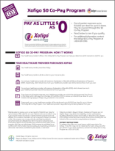ACCESS
COPAY ASSISTANCE WITH XOFIGO®
Xofigo $0 Copaya Savings Program
Your patient may be eligible for copay/coinsurance assistance if your patient has a private commercial plan that covers Xofigo.
- Out-of-pocket expenses up to $10,000 per dose for up to 6 doses may be covered through the $0 Copay Program
PLEASE NOTE: If your patient has public insurance (eg, Medicare or other government payors, such as the Department of Veterans Affairs and Department of Defense), your patient is not eligible.
HERE’S HOW TO APPLY:

Confirm your patient is eligible. Eligibility criteria include:
- Private commercial insurance
- Residency in the United States, including the District of Columbia, Puerto Rico, Guam, or the US Virgin Islands


Complete the Xofigo $0 Copay Reimbursement Form on your patient’s behalf.

Ensure both the patient and physician sign and date the application.

Send the application to Xofigo® Access Services via secure email in the portal. You can also fax the application to Xofigo Access Services at 1-855-963-4463. Remember to include the signed patient authorization. Contact Xofigo Access Services if you have any questions or to obtain more information. Both you and your patient will then receive an Explanation of Payment (EOP) and Explanation of Benefits (EOB), respectively, which show how much was reimbursed and how much your patient owes.

Once approved, your patient will receive an approval letter with commercial copay/coinsurance identification information. Then, you or your patient will be reimbursed up to $10,000 per dose for up to 6 doses. You may also collect any remaining balance from your patient.
Copay assistance for patients with public insurance
- Medicare beneficiaries and patients with other government insurance who need help paying for treatment with Xofigo are not eligible for copay assistance through the Xofigo Access Services commercial copay/coinsurance assistance program
- If your patient needs assistance with cost-share requirements for Xofigo, they may be eligible for copay or coinsurance assistance through an independent copay/coinsurance assistance foundation
- Xofigo Access Services Access Counselors can verify your patients’ coverage for Xofigo
- If copay assistance needs are identified, an Access Counselor can provide information about any available foundation
- The foundations determine your patient’s eligibility for copay or coinsurance assistance based on their own criteria
Comprehensive support right when you need it

Counselors are available from 9:00 AM to 7:00 PM ET, Monday through Friday:
- Call 1-855-6XOFIGO (1-855-696-3446)
- Fax 1-855-963-4463
- Visit XofigoAccessOnline.com
For helpful resources, click here.
aPatients who are enrolled in any type of government insurance or reimbursement programs are not eligible. As a condition precedent of the copayment support provided under this program, e.g., copay refunds, participating patients and pharmacies are obligated to inform insurance companies and third-party payors of any benefits they receive and the value of this program, as required by contract or otherwise. Void where prohibited by law, taxed, or restricted. Patients enrolled in Bayer’s Patient Assistance Program are not eligible. Bayer may determine eligibility, monitor participation, equitably distribute product and modify or discontinue any aspect of the Xofigo Access Services at any time, including but not limited to this commercial copay assistance program. Only patients not currently enrolled in the Xofigo Access Services are eligible; current participants may enroll upon their annual renewal date.
$0 Commercial Copaya Assistance Program
Your patient may be eligible for copay/coinsurance assistance if your patient has a private commercial plan that covers Xofigo.b Patients approved for assistance will not have to pay anything to access Xofigo.
PLEASE NOTE: If your patient has public insurance (eg, Medicare or other government payors, such as the Department of Veterans Affairs and Department of Defense), your patient is not eligible. Learn more
How to apply:

- Private commercial insurance
- Residency in the United States, including the District of Columbia, Puerto Rico, Guam, or the US Virgin Islands

- Complete the Xofigo Access Services Commercial Copay Assistance Application PDF on your patient’s behalf


- Ensure both the patient and physician sign and date the application

- Fax the application, including the signed patient authorization, to Xofigo Access Services at 1-855-963-4463
- Contact Xofigo Access Services if you have any questions or to obtain more information

- Once approved, your patient will receive an approval letter with a commercial copay/coinsurance identification (ID) card
Copay assistance for patients with public insurance
-
Medicare beneficiaries and patients with other government insurance who need help paying for treatment with Xofigo are not eligible for copay assistance through the Xofigo Access Services commercial copay/coinsurance assistance program
-
If your patient needs assistance with cost-share requirements for Xofigo, they may be eligible for copay or coinsurance assistance through an independent copay/coinsurance assistance foundation
-
Xofigo Access Services Access Counselors can verify your patients’ coverage for Xofigo. Use the Xofigo Access Services Provider Referral Form
-
If copay assistance needs are identified, an Access Counselor can provide information about any available foundation
-
The foundations determine your patient’s eligibility for copay or coinsurance assistance based on their own criteria
Comprehensive support right when you need it

Counselors are available from 9:00 AM to 7:00 PM ET, Monday through Friday:
- Call 1-855-6XOFIGO (1-855-696-3446)
- Fax 1-855-963-4463
- Visit XofigoAccessOnline.com
aPatients who are enrolled in any type of government insurance or reimbursement programs are not eligible. As a condition precedent of the copayment support provided under this program, e.g., copay refunds, participating patients and pharmacies are obligated to inform insurance companies and third-party payors of any benefits they receive and the value of this program, as required by contract or otherwise. Void where prohibited by law, taxed, or restricted. Patients enrolled in Bayer’s Patient Assistance Program are not eligible. Bayer may determine eligibility, monitor participation, equitably distribute product and modify or discontinue any aspect of the Xofigo Access Services at any time, including but not limited to this commercial copay assistance program. Only patients not currently enrolled in the Xofigo Access Services are eligible; current participants may enroll upon their annual renewal date.
bThe Xofigo Commercial Copay Assistance identification card is not a credit or debit card, and no cash or ATM access is available. This card cannot be used in any other capacity outside of copay assistance for Xofigo.


